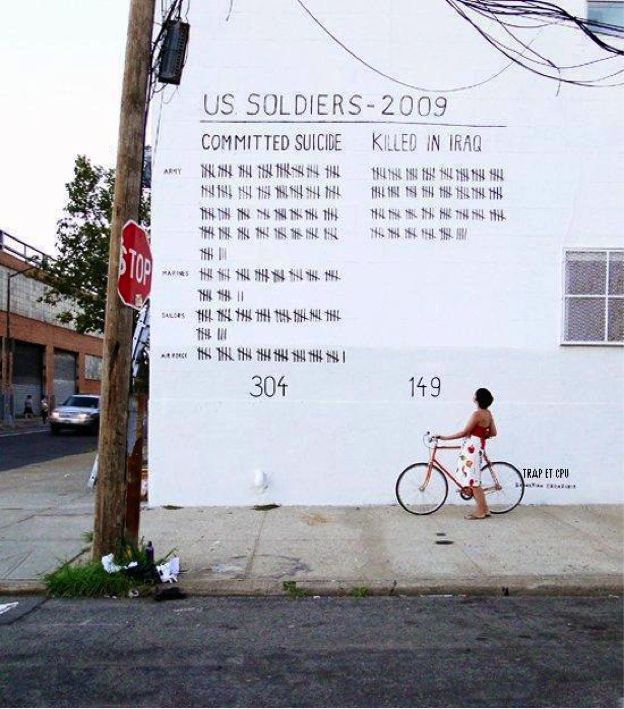
Suicide is Painless
Counting war casualties is in no small way dependent on how one defines war to begin with — this particularly holds true when it comes to accounting for the beginnings and endings of wars, as this discursive signpost represents one of the prime “cuts” of measure in casualty accounting. Thus, one finds that different conceptual and nominal understandings of war, when combined with different concepts of time and duration and what counts as a casualty, have an influence on statistical measures and outcomes.
Unstable identity categories like “civilian” and “soldier” also exert a major impact on casualty reporting. While it is well known among historians and statisticians that states and armies throughout history have not employed official standardized measures to account for war casualties, the tendency among most people is to accept the reporting of casualty statistics as cold, hard, fact. In view of these findings, one discovers rather quickly that what “counts” as a soldier, more specifically a soldier’s body, and particularly a wounded soldier’s body, is not categorically consistent. There is considerable variation with regard to who and how one counts, which differs dramatically depending on the contingencies of specific wars and conflicts.
Equally troubling is the fact that there are many circumstances where the body might be wounded, yet not reveal signs of an identifiable injury or physical scar; other bodies might be wounded without experiencing war; and some bodies are injured without ever being deployed to a conventional battle theater. The lack of a clear answer prompts Judith Butler (2006) to ask, “why is it that sometimes numbers don’t count at all?”
Discussion Questions
Do you think injuries that can be seen on a body are more significant than less visible injuries that affect the mind (i.e. like those reported/unreported by soldiers who evidence symptoms of PTSD)?
How should we count suicides? Are they combat injuries? Why might the military not want to count suicides?
What about civilian casualties from 9/11? Are they too combat casualties? If not, why not? What is the major difference?
What about other civilian casualties and casualties from countries with whom we are not officially “at war?” Are they combat casualties?
How should we count the civilians killed and wounded in missile/drone strikes in the Palestinian territories and in Pakistan? Are they war casualties? Are New York City, Gaza, and North Waziristan not battlefields?

I honestly cant answer the question “ Do you think injuries that register visible on a body are more significant than other less visible injuries that affect the mind”. I feel that both injuries are equally important because they hold a huge weight on the individual with the ordeal they’ve dealt with. I cant imagine loosing a limb nor can I imagine seeing the horrors of war playing over and over in my head. A visible injury can be a constant reminder of the incident but PTSD is also very self inflictive and agonizing.. Both injuries has negative impacts on a person’ s well being. Both visible and invisible wounds are important to the person with them, and should be important to those around them. Suicide is a combat injury. It’s a serious aftermath of war that goes unnoticed and under reported.
Injuries that are visible on a body sometimes are less significant than those affecting the mind. A soldier who lost his leg on the battlefield is treated right the way with the appropriate care for fast rehabilitation. Physical problems can be easily identified and can not go unacknowledged or ignored. The demanding environment of military life and battlefield experiences lead many soldiers to experience psychological distress, mental illness and substance abuse that can easily be hidden. When left untreated, they will lead to a steady and rapid decline in mental health necessitating more intensive treatment when discovered or to a person taking their lives because of unbearable and unmanageable pain.
Combat injuries or any injuries caused by military deployments, mental or physical, along with their repercussions such as suicides or murders, at home or abroad, should be defined as war casualties. If it wasn’t for the war, the soldier suffering from mental illness and nightmares of what happened on the field who decide to end his life, would not be a reality. The public do not realize that more soldiers die by committing suicide when they return in the United States than by being killed in combat zones. This is a stunning fact. Even if there is no war in the next decades, the psychological and physical damages on soldiers will remain.
I think that physical injuries are considered more significantly damaging because it’s a lot easier to sympathize with something you can physically see. Things that effect the mental such as PTSD are considered to some as a weakness so therefore people are hesitant to have it documented because of the stigma attached to it. For example, in the Armed Forces you can reprimanded for suicidal thoughts and even as far as being discharged. The military prides itself for being “tough” and being able to “soldier up” and “drive on” so admittance of issues such as PTSD and suicidal thoughts can be heavily frowned upon.